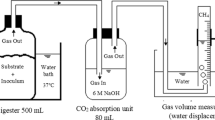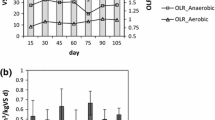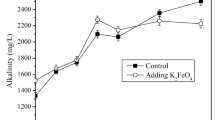Abstract
During anaerobic digestion, low-organic-content sludge sometimes is used as feedstock, resulting in deteriorated digestion performance. The operational experience of conventional anaerobic digestion cannot be applied to this situation. To investigate the feature of low-organic-content sludge digestion and explain its intrinsic mechanism, batch experiments were conducted using designed feedstock having volatile solids (VS) contents that were 30–64% of total solids (TS). The results showed that the accumulative biogas yield declined proportionally from 173.7 to 64.8 ml/g VS added and organic removal rate decreased from 34.8 to 11.8% with decreasing VS/TS in the substrate. The oligotrophic environment resulting from low-organic-content substrates led to decreased microbial activity and a switch from butyric fermentation to propionic fermentation. A first-order model described the biogas production from the batch experiments very well, and the degradation coefficient decreased from 0.159 to 0.069 day−1, exhibiting a positive relation with organic content in substrate. The results observed here corroborated with data from published literature on anaerobic digestion of low-organic-content sludge and showed that it may not be feasible to recover energy from sludge with an organic content lower than 50% through mono digestion.





Similar content being viewed by others
Explore related subjects
Discover the latest articles and news from researchers in related subjects, suggested using machine learning.References
Anthonisen AC, Loehr RC, Prakasam T, Srinath EG (1976) Inhibition of nitrification by ammonia and nitrous acid. JWater Pollut Control Fed 48:835–852
Appels L, Baeyens J, Degrève J, Dewil R (2008) Principles and potential of the anaerobic digestion of waste-activated sludge. Prog Energ Combust 34:755–781
Cao Y, Paw Owski A (2012) Sewage sludge-to-energy approaches based on anaerobic digestion and pyrolysis: brief overview and energy efficiency assessment. Renew Sust Energ Rev 16:1657–1665
Dai X, Duan N, Dong B, Dai L (2013) High-solids anaerobic co-digestion of sewage sludge and food waste in comparison with mono digestions: stability and performance. Waste Manag 33:308–316
Dai X, Zhao Y, Sha C, Dai L, Dong B (2014) Investigation on the status and causes of sludge sand content of wastewater treatment plants in China. Water Wastewater Eng75-78, 79
Di Maria F, Micale C, Contini S (2016) Energetic and environmental sustainability of the co-digestion of sludge with bio-waste in a life cycle perspective. Appl Energ 171:67–76
Duan N, Dong B, Wu B, Dai X (2012) High-solid anaerobic digestion of sewage sludge under mesophilic conditions: feasibility study. Bioresour Technol 104:150–156
Dubois M, Gilles KA, Hamilton JK, Rebers PA, Smith F (1956) Colorimetric method for determination of sugars and related substances. Anal Chem 28:350–356
Jensen PD, Ge H, Batstone DJ (2011) Assessing the role of biochemical methane potential tests in determining anaerobic degradability rate and extent. Water Sci Technol 64:880–886
Kafle GK, Kim SH (2013) Anaerobic treatment of apple waste with swine manure for biogas production: batch and continuous operation. Appl Energ 103:61–72
Kafle GK, Kim SH, Sung KI (2013) Ensiling of fish industry waste for biogas production: a lab scale evaluation of biochemical methane potential (BMP) and kinetics. Bioresour Technol 127:326–336
Kameswari KSB, Kalyanaraman C, Porselvam S, Thanasekaran K (2012) Optimization of inoculum to substrate ratio for bio-energy generation in co-digestion of tannery solid wastes. Clean Technol Envir 14:241–250
Koch K, Helmreich B, Drewes JRE (2015) Co-digestion of food waste in municipal wastewater treatment plants: effect of different mixtures on methane yield and hydrolysis rate constant. Appl Energ 137:250–255
Liao X, Li H (2015) Biogas production from low-organic-content sludge using a high-solids anaerobic digester with improved agitation. Appl Energ 148:252–259
Liao X, Li H, Cheng Y, Chen N, Li C, Yang Y (2014) Process performance of high-solids batch anaerobic digestion of sewage sludge. Environ Technol 35:2652–2659
Liao X, Li H, Zhang Y, Liu C, Chen Q (2016) Accelerated high-solids anaerobic digestion of sewage sludge using low-temperature thermal pretreatment. Int Biodeter Biodegr 106:141–149
Liu C, Li H, Zhang Y, Chen Q (2016) Characterization of methanogenic activity during high-solids anaerobic digestion of sewage sludge. Biochem Eng J 109:96–100
Liu G, Zhang R, El-Mashad HM, Dong R (2009) Effect of feed to inoculum ratios on biogas yields of food and green wastes. Bioresour Technol 100:5103–5108
Lowry OH, Rosebrough NJ, Farr AL, Randall RJ (1951) Protein measurement with the folin phenol reagent. J Biol Chem 193:265–275
Luo K, Yang Q, Li X, Yang G, Liu Y, Wang D, Zheng W, Zeng G (2012) Hydrolysis kinetics in anaerobic digestion of waste activated sludge enhanced by α-amylase. Biochem Eng J 62:17–21
Ministry of Environmental Protection, China. Standard methods for the examination of water and wastewater. Beijing: China Environmental Science Press, 2002
Palatsi J, Laureni M, Andrés MV, Flotats X, Nielsen HB, Angelidaki I (2009) Strategies for recovering inhibition caused by long chain fatty acids on anaerobic thermophilic biogas reactors. Bioresour Technol 100:4588–4596
Pantaleo A, Gennaro BD, Shah N (2013) Assessment of optimal size of anaerobic co-digestion plants: an application to cattle farms in the province of Bari (Italy). Renew Sust Energ Rev 20:57–70
Poeschl M, Ward S, Owende P (2010) Evaluation of energy efficiency of various biogas production and utilization pathways. Appl Energ 87:3305–3321
Raposo F, Borja R, Martín MA, Martín A, de la Rubia MA, Rincón B (2009) Influence of inoculum–substrate ratio on the anaerobic digestion of sunflower oil cake in batch mode: process stability and kinetic evaluation. Chem Eng J 149:70–77
Rice EW, Baird RB, Eaton AD, Clesceri LS (2012) Standard methods for examination of water and wastewater. APHA AWWA WEF, Washington, DC
Van Stappen F, Mathot ML, Decruyenaere V, Loriers A, Delcour A, Planchon V, Goffart J, Stilmant D (2016) Consequential environmental life cycle assessment of a farm-scale biogas plant. J Environ Manag 175:20–32
Wang Q, Kuninobu M, Ogawa HI, Kato Y (1999) Degradation of volatile fatty acids in highly efficient anaerobic digestion. Biomass Bioenergy 16:407–416
Zhang C, Su H, Tan T (2013) Batch and semi-continuous anaerobic digestion of food waste in a dual solid–liquid system. Bioresour Technol 145:10–16
Zhang Y, Li H, Cheng Y (2015) Influencing mechanism of high solid concentration on anaerobic mono-digestion of sewage sludge without agitation. Front Env Sci Eng 9:1108–1116
Zhen G, Lu X, Kobayashi T, Li Y, Xu K, Zhao Y (2015) Mesophilic anaerobic co-digestion of waste activated sludge and Egeria densa: performance assessment and kinetic analysis. Appl Energ 148:78–86
Funding
This work was supported by the China Major Science and Technology Program for Water Pollution Control and Treatment (grant number 2011ZX07302); the Natural Science Foundation of China (grant number 51478239); and the Shenzhen Science and Technology Project (grant number JCYJ20170307152224920).
Author information
Authors and Affiliations
Corresponding author
Additional information
Responsible editor: Bingcai Pan
Rights and permissions
About this article
Cite this article
Zhang, Y., Li, H. Energy recovery from wastewater treatment plants through sludge anaerobic digestion: effect of low-organic-content sludge. Environ Sci Pollut Res 26, 30544–30553 (2019). https://doi.org/10.1007/s11356-017-0184-y
Received:
Accepted:
Published:
Issue Date:
DOI: https://doi.org/10.1007/s11356-017-0184-y




